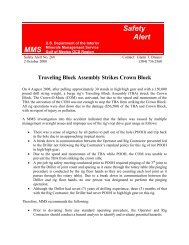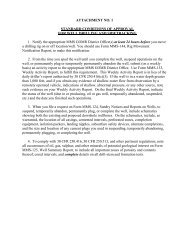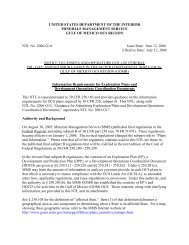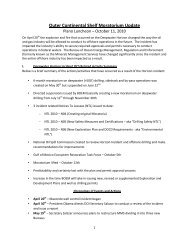Deepwater Gulf of Mexico 2004: America's Expanding ... - OCS BBS
Deepwater Gulf of Mexico 2004: America's Expanding ... - OCS BBS
Deepwater Gulf of Mexico 2004: America's Expanding ... - OCS BBS
- No tags were found...
Create successful ePaper yourself
Turn your PDF publications into a flip-book with our unique Google optimized e-Paper software.
Reduction <strong>of</strong> royalty payments is also available through an application process for some deepwater fields<br />
that were leased prior to the DWRRA but had not yet gone on production. The fixed suspension volume<br />
provision <strong>of</strong> the DWRRA (for new leases issued 1996-2000) expired on November 28, 2000. Leases<br />
acquired between November 28, 1995, and November 28, 2000, will retain the incentives until their<br />
expiration. Exploration and production incentives have continued since 2000 for leases in water depths<br />
greater than 400 m (1,312 ft). Royalty relief volumes range from 5 MMBOE in water depths <strong>of</strong><br />
400-799 m (1,312-2,621 ft) to 12 MMBOE <strong>of</strong> relief in depths greater than 1,600 m (5,249 ft). Royalty<br />
relief is granted to individual leases, not fields 1 as in the DWRRA. Post-DWRRA provisions are subject<br />
to change for each lease sale.<br />
SEISMIC ACTIVITY<br />
A combination <strong>of</strong> factors including the DWRRA, several key deepwater discoveries, the recognition <strong>of</strong><br />
high deepwater production rates, and the evolution <strong>of</strong> deepwater development technologies, spurred a<br />
variety <strong>of</strong> deepwater activities. One <strong>of</strong> the first impacts was a dramatic increase in the acquisition <strong>of</strong> 3-D<br />
seismic data (figure 2). (Note that figures 2 and 3 illustrate areas permitted for seismic acquisition. The<br />
actual coverage available may be slightly different than that permitted.) Three-dimensional seismic data<br />
are huge volumes <strong>of</strong> digital energy recordings resulting from the transmission and reflection <strong>of</strong> sound<br />
waves through the earth. These large “data cubes” can be interpreted to reveal likely oil and gas<br />
accumulations. The dense volume <strong>of</strong> recent, high-quality data may reduce the inherent risks <strong>of</strong> traditional<br />
hydrocarbon exploration and allow imaging <strong>of</strong> previously hidden prospects. Figure 2 illustrates the surge<br />
<strong>of</strong> seismic activity in the deepwater GOM during the last 12 years. Seismic acquisition has stepped into<br />
progressively deeper waters since 1992. Figure 3 shows the abundance <strong>of</strong> 3-D data now available. These<br />
data blanket most <strong>of</strong> the deepwater GOM, even beyond the Sigsbee Escarpment (a geologic and<br />
bathymetric feature in ultra-deep water). Note that many active deepwater leases were purchased before<br />
these 3-D surveys were completed (only the more sparsely populated 2-D datasets were available).<br />
The seismic permitting coverage shown in figure 3 does not tell the whole story <strong>of</strong> geophysical activity in<br />
the deepwater GOM. Pre-stack depth migration (PrSDM) <strong>of</strong> seismic data has greatly enhanced the<br />
interpretation capabilities in the deepwater GOM, particularly for areas hidden below salt canopies.<br />
While PrSDM was once used sparingly, the availability <strong>of</strong> large speculative PrSDM surveys allows the<br />
widespread use <strong>of</strong> this technology in the early phases <strong>of</strong> exploration. Subsalt discoveries like Mad Dog,<br />
Thunder Horse, North Thunder Horse, Atlantis, and Tahiti demonstrate the importance <strong>of</strong> subsalt<br />
exploration. Figure 4 provides a partial inventory <strong>of</strong> speculative PrSDM coverage. This figure was<br />
assembled from publicly available sources and provides a good indication <strong>of</strong> the current widespread<br />
coverage <strong>of</strong> PrSDM processing.<br />
Time-lapse seismic surveys (also known as 4-D) will likely be the next significant seismic technology to<br />
be applied routinely in the deepwater GOM. The technique can be applied to characterize reservoir<br />
properties, monitor production efficiency, and estimate volumetrics from inception through the life <strong>of</strong> the<br />
field (Shirley, 2001). The high cost <strong>of</strong> drilling deepwater wells and challenges associated with reentry <strong>of</strong><br />
deepwater wells may promote the use <strong>of</strong> 4-D technology in the deepwater GOM.<br />
EXPLORATION ACTIVITY<br />
Modern seismic data <strong>of</strong>ten generate new ideas leading to surges in leasing and drilling activities.<br />
Exploration drilling in the deepwater GOM in 2002 and 2003 has found over 2 billion BOE. Traditional<br />
deepwater mini-basin plays are still providing many exploration opportunities (consider the Thunder<br />
Horse and North Thunder Horse discoveries in southern Mississippi Canyon), but recent discoveries in<br />
new deepwater plays continue to expand the exploration potential <strong>of</strong> the deepwater GOM. Figure 5<br />
illustrates the fact that 99 percent <strong>of</strong> total GOM production is from Neogene-age reservoirs (Pleistocene,<br />
Pliocene, and Miocene); however, several recently announced deepwater discoveries encountered large<br />
potential reservoirs in sands <strong>of</strong> Paleogene age (Oligocene, Eocene, and Paleocene). This older portion <strong>of</strong><br />
the geologic section has been very lightly tested in the GOM and the discovery <strong>of</strong> reservoirs <strong>of</strong> this<br />
geologic age may open wide areas <strong>of</strong> the GOM to further drilling. Figure 6 illustrates two frontier<br />
6







